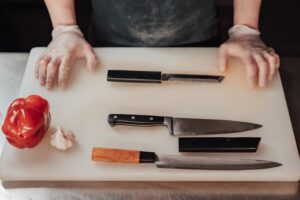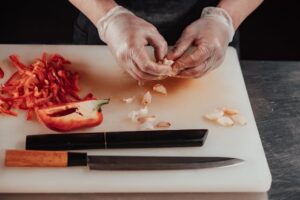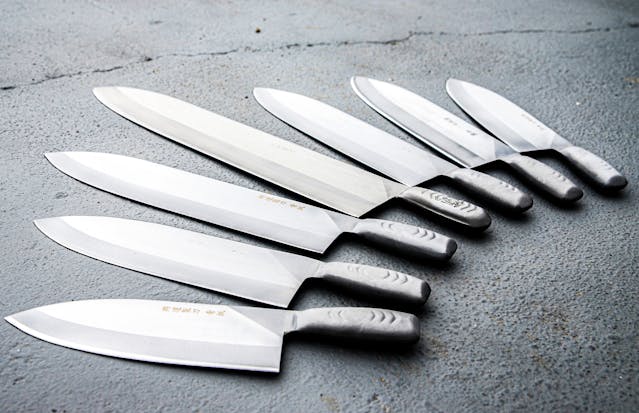Kitchen Knives Types
However, no kitchen can be better than tools it has, and as cooking is concerned right kitchen knives types play a huge role. It does not matter if you are a pro chef or just a beginner in cooking; the cooking knives that will be used depend on what type of things will be prepared for safe cooking and efficient food preparation. But with tons of choices, how do you figure out which to choose? In this section, we provide a road map to the pantry knife world and identify which types you should have depending on your chef’s style.
A Cut Above: Choosing the Right kitchen knives types
Knives a clean home just wouldn’t be the same using a set of great knives. There are so many varieties these days that finding the right ones for yourkitchen knives types can be tricky. A primer to the most important types of kitchen utensils and their use in your daily food prep.
Essential Kitchen Knives

1. Chef Knife
A chef’s utility knife is the backbone of every kitchen. It is the most capable of all types of knives and can complete almost any slicing task. It will chop veggies, slice meat.
- Uses: intent knife for cuts, cutting, and combing many types of things.
- Slice Size: 8–10 inches
- Main Characteristics: The curved blade of a kitchen knives types enables the rocking motion essential for chopping. It has often a comfortable handle and the blade is usually sharp with a pointed tip.
A decent chef knife should fit your palm and have the balance needed for precision work. Invest in only one knife prioritize that on this.
2. Paring Knife
Paring knife Is very small but its essential kitchen tool. This is great for precise work like peeling fruit, trimming fat, or coring vegetables.
- Function: Peeling, trimming and coring fruit and veggies. Best for more delicate tasks.
- Blade Length: 2–4 inches
- Features: The paring knife is equipped with a small, sharp blade designed for precision and detailed cutting tasks. It serves you control and control for the tasks where finesse is required.
So small, the paring knife is a must for tasks that larger knives would compete with.
3. Santos Knife
The Santos blade knife is an all-purpose Chinese kitchen knife, which can be used to chop, cut, and mince with one hand in no time. The blade is a bit flatter than your average chef blade, and it’s more used for slicing in uniform arcs.
- Use: All-purpose utility knife useful for chopping, slicing, and mincing
- Blade Length: 6–7 inches
- Properties: The blade of the Santos knife is straight and has a gran ton edge (small indentations) on one side of the blade. Such small cuts mitigate friction and ensure food does not stick to the blade, making it an excellent choice for slicing flaky fish or other thin vegetables.
The Santos knife is adored by a great many chefs as it offers the perfect blend of utility and precision. This topic is a good choice for novices and experts alike.
4. Serrated Utility Knife
Serrated utility knife Serrated utility knife .A serrated utility knife cuts neatly through soft foods, like tomatoes or bread or cake without squashing them. With saws teeth that hold the food and glide right through.
- Use: Ideal for slicing bread, tomatoes, and other soft foods with a lot of moisture so you don’t squash them.
- Blade Length: 5–6 inches
- Highlights: The serrated blade means you can slice through a crusty outside and soft inside without ruining it. Further, perfect for soft fruits or cheeses.
It’s the kind of tool that you don’t notice the absence of until you own one and start using it in your kitchen. Now it will churn out the most effortless slices of bread and tomatoes.
5. Boning Knife
A fishing knife, or also called as a fillet knife, is a type of knife for cutting the meat away from the bone. It’s a great tool for peeling fat, taking off skin, or dicing chicken.
- Uses: To debone meat from bones and to remove excess fat.
- Blade Length: 5–7 inches
- Highlights: Flexibility enables the boning knife to cut along bones. The reason you want a pointed tip is that it gives you the control necessary for close cuts!
A boning knife is an absolute essential of the kitchen for anyone who regularly works with raw meat.
Additional Considerations

Blade Material
The selection of the blade material can make a huge difference between performance quality, durability, and maintenance of your knives. Here are some common options:
- Premium Steel: This is the most used blade stuff, supply durability, easy repair, and resistance to rust. Those stainless steel knives are pretty affordable and can restore its sharpness at any time.
- High-Carbon Steel: Cognized for its excellent edge durability, high-carbon steel razors can stay sharp for longer periods. Still, they are more likely to rust and require regular upkeep.
- Ceramic: Highly sharp and lightweight, ceramic blades are ideal for precision cutting. Still, they can chip or break if dropped, making them less durable than iron knives.
Every sort of wood comes with its pros and cons, so it’s necessary to decide the one that best suits your cooking style and abilities to maintain your cutlery.
Handle Material
You should know that the handle of your knife has a significant bearing on comfort, control, and overall user experience. Here are some typical materials for facade handles:
- Wood: They are comfortable and have a timeless glow aesthetic, a classic choice. But they need to be oiled of regularly, so they continue looking good and don’t get damaged.
- Plastic-Sturdy: and easy to clean, plastic handles are generally used in inexpensive knives. They work fine, but certainly do not scream premium as wood or Marta would.
- Marta :Marta is a thermoses plastic material made of fabric or paper layers layered in resin, creating tough, water-repellant and sanitary handles with an upscale appearance.
What is the best handle material for you is really subjective based on what weight and feel that you like to have in a knife.
Handle Style
There are two main grip styles to pick from:
- Western: Typically having either a full tang (where the blade flows into the handle) or a half tang (where the blade only partially grows)), Feature handles offer good stability and control.
- Japanese: Asian knives regularly come with either a Style (traditional Japanese) or Yo-style (Western-influenced) handle, each offering unique grip options and pleasure levels.
The choice out of these styles mostly comes down to personal styles and level of comfort.
Knife Care

Proper care is vital to keeps your knives up to date and serve its best function.
- Cutting: If you sharpen your knives a bit, it would keep the blade sharp. This can be done using a sharpening stone, sharpening rod or expertly cut.
- To clean: Always wash them by hand with a mild wetter, dishwasher can dull the blades. Take time to pat your knives dry after use so they do not rust.
- Storing knives wisely puts off the sharp edge. Store the tools in a knife block, magnetic strip, or each knife may have its own sheath to protect it from dents or nicks.
Cleaning your knives and caring for them regularly will allow you to get the most out of their usage
Conclusion
Kitchen knives are one of the most essential pieces of kitchen gear to have on hand, and having the right knife can greatly boost safety in your kitchen or facilitate efficient cooking. From the durable chef’s knife to a precision paring knife and a reliable boning knife available, knowing what types of knives you have on your menu will help keep your delicious creation decision in check.
With some thought into the material of the blade, whether you like a traditional handle or modern style, plus how each knife works for those tasks, your collection of kitchen knives typeswill improve your cooking enjoyment. These knives will be great tools for you, and they will serve you well so long as you care for them properly. For years to come, doing your time in the eatery more fun and creative.
if you want to know more about us then click here.
Short FAQs
Which spoon is the most needed in the kitchen?
A chef’s knife is an crucial tool in the restaurant, usually used for cutting, fading, and chopping any kind of food.
What may be my top choices while procuring a knife for my home office?
Think about the actions you do most often in your kitchen. Most cuisines require a chef’s knife, pairing knife and a chef’s portable knife. You don’t just go with a focus on blade finish and hand style but also care ethics.
How to maintain kitchen knives?
This means sharpening them from time to time, washing by hand in soapy water and drying it right away, storing it in a knife block or utensil sheath: basically keeping the blade safe.
What is the difference between a chef knife and a Santos knife?
The chef knife has a curved blade enabling rocking cuts, while the Santos model typically has a flatter blade and is used for chopping, slicing and mincing especially in Japanese cuisine.
Are ceramic knives a good option?
Alumina ceramic knives are really sharp and light, which makes them ideal for precise chopping. However they can chip or break if dropped so should be handled with a little more care.
Difference Table
| Knife Type | Purpose | Blade Length | Key Features |
|---|---|---|---|
| Chef’s Knife | All-purpose cutting, chopping, slicing | 8–10 inches | Curved blade for rocking motion, comfortable handle |
| Paring Knife | Delicate tasks like peeling, trimming, and coring | 2–4 inches | Small, sharp blade for precision cutting |
| Santos Knife | Chopping, slicing, mincing | 6–7 inches | Flat blade with Grafton edge to reduce sticking |
| Serrated Utility Knife | Remove bread, tomatoes, and soft foods without squashing | 5–6 inches | knife edge for smooth cutting |
| Boning Knife | Removing meat from bones, trimming fat | 5–7 inches | Powerful blade for precise cuts |

3 thoughts on “How to Choose the Kitchen Knives Types for Your Culinary Needs”